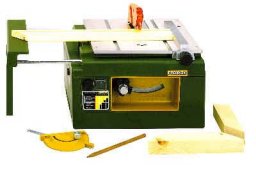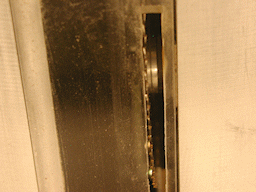The subtitle on the first page of this write-up refers to the fact that, as it evolved, this project turned out to be (aside from re-learning trigonometry--Here's to you, Mr. Poole) more about learning how to make box joints than anything else.
This was my first attempt to cut box joints and, in fact, my first serious use of a table saw of any size. Somebody may find useful a discussion of the tools used during the construction of the sanding box.
Box joints can also be cut using a router. From my reading, it appears that using a table saw is overall the easier method. Some jigs made for full-size table saws will cut joints down to 1/4 inch or less. I suspect these might produce much better results than the Proxxon saw/dado washer combination I discuss on the following pages.
will cut joints down to 1/4 inch or less. I suspect these might produce much better results than the Proxxon saw/dado washer combination I discuss on the following pages.
I'd be interested in hearing from users of other miniature saws or anyone who has found alternative methods.
TOOLS
Some of the above listed tools are used in the TECHNIQUES section on the following page. I'm only going to specifically address a couple of them here.
1. Proxxon 38070 FKS/E Table Saw
- This saw is fast, powerful, acceptably quiet and capable of fair precision. It's not a Preac or Jimsaw, but neither is the price. If you lurk on a model ship builder's or miniature woodworker's forum and follow the discussions, you may decide that the difference in price is worthwhile for one of these finer precision machines.
- The MicroLux Table Saw sold by Micro-Mark is essentially identical. From photos in the catalog it appears that, aside from color, the only difference is that the Microlux version has a longer and more secure fence. If that is the case, it would be a definite improvement. Accessories sold for one saw will fit the other.
 |
|
| 2. Dado Washers
- Proxxon makes a dado head set
 , but the specs state the width of the cut is only 5/64 inch--far too narrow for creating box joints--and the blade guard would interfere. , but the specs state the width of the cut is only 5/64 inch--far too narrow for creating box joints--and the blade guard would interfere.
- Micro-Mark sells a set of dado washers for the MicroLux saw, which also fit the Proxxon. These are aluminum washers with a tapered cross section. When placed on the shaft with the 80-tooth Standard (aka crosscut, Supercut) blade, they cause a wobble effect which effectively widens the cut. The widest dado possible is 3/16 inch. Though not precise, it worked reasonably well in cutting the tenons.
- Micro-Mark has a long-standing habit of buying off-the-shelf items, renaming them, writing a hyperbolic catalog description and selling them at a premium price. Knowing this, I spent a couple days searching for an alternate source. This appears to be one item that is specially fabricated.
- You'll also need one of the blank blade plates sold by Micro-Mark, as the wobble will cause the blade to strike the plate that comes standard with the saw.
|
 |
will cut joints down to 1/4 inch or less. I suspect these might produce much better results than the Proxxon saw/dado washer combination I discuss on the following pages.




![]()